Comparative Analysis of Bitcoin and Ripple Cryptocurrency Systems
VerifiedAdded on 2022/09/18
|11
|2514
|30
Report
AI Summary
This report provides a comprehensive analysis of Bitcoin and Ripple, two prominent cryptocurrencies. It begins by defining Ripple and exploring its architecture, features, and associated challenges. The report then delves into the applications of Bitcoin, examining its role as a platform and a system of record. A comparative study is conducted, highlighting the key differences between Bitcoin and Ripple, particularly focusing on their decentralization approaches and market dynamics. The report concludes with a summary of the findings, emphasizing the evolution of Bitcoin as a platform and the implications of Ripple's centralized structure. The report uses information from various sources and provides an understanding of the cryptocurrency landscape.
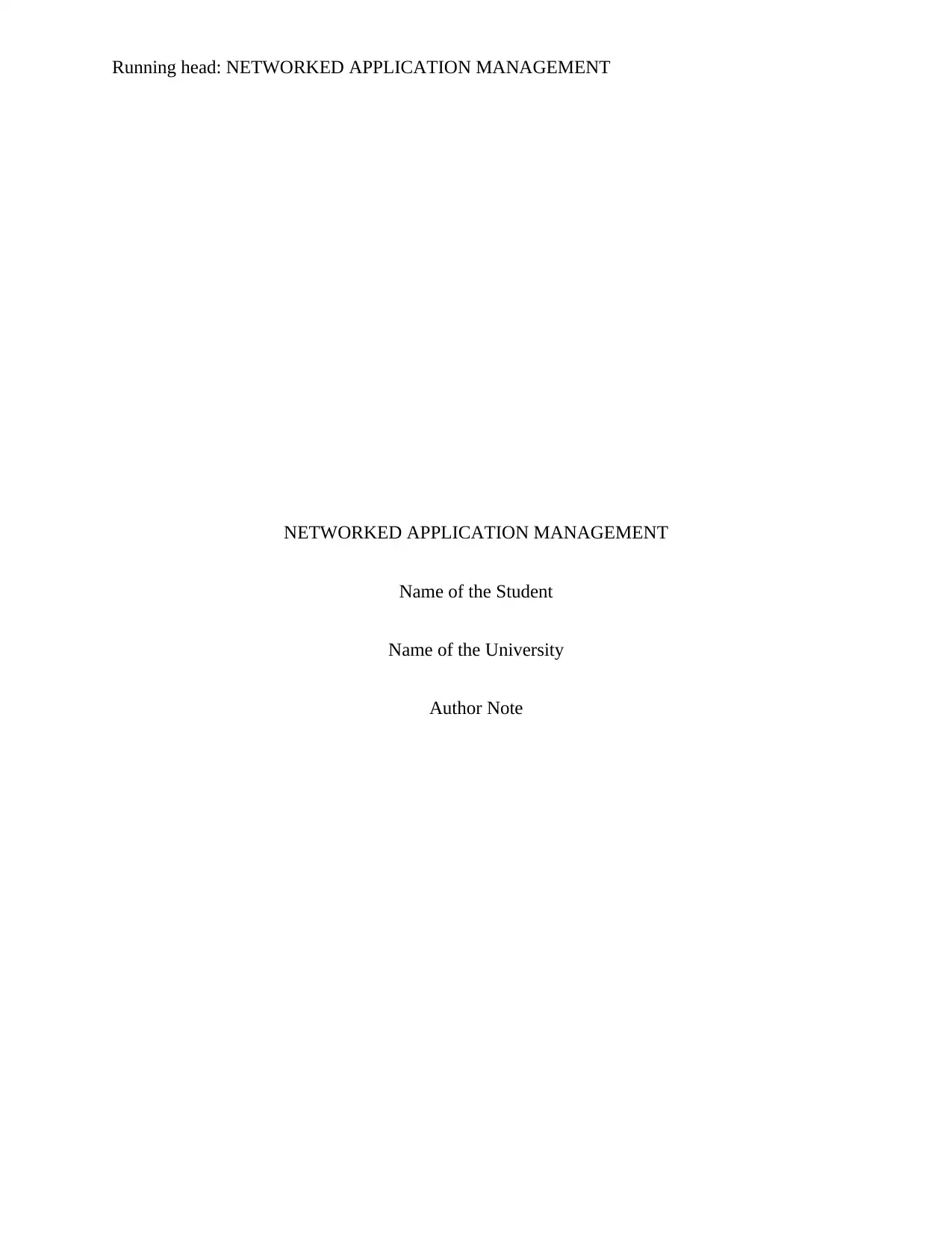
Running head: NETWORKED APPLICATION MANAGEMENT
NETWORKED APPLICATION MANAGEMENT
Name of the Student
Name of the University
Author Note
NETWORKED APPLICATION MANAGEMENT
Name of the Student
Name of the University
Author Note
Paraphrase This Document
Need a fresh take? Get an instant paraphrase of this document with our AI Paraphraser
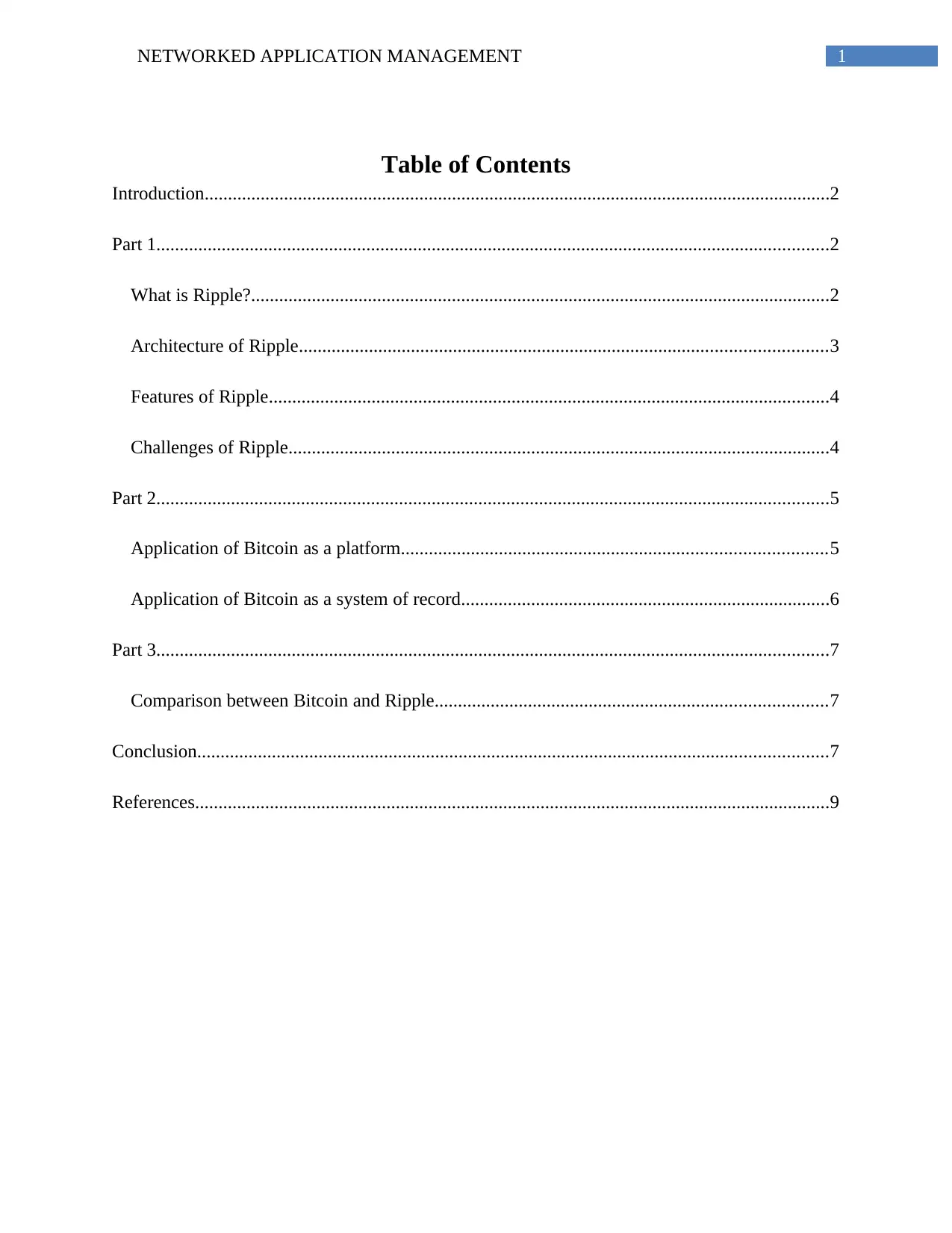
1NETWORKED APPLICATION MANAGEMENT
Table of Contents
Introduction......................................................................................................................................2
Part 1................................................................................................................................................2
What is Ripple?............................................................................................................................2
Architecture of Ripple.................................................................................................................3
Features of Ripple........................................................................................................................4
Challenges of Ripple....................................................................................................................4
Part 2................................................................................................................................................5
Application of Bitcoin as a platform...........................................................................................5
Application of Bitcoin as a system of record...............................................................................6
Part 3................................................................................................................................................7
Comparison between Bitcoin and Ripple....................................................................................7
Conclusion.......................................................................................................................................7
References........................................................................................................................................9
Table of Contents
Introduction......................................................................................................................................2
Part 1................................................................................................................................................2
What is Ripple?............................................................................................................................2
Architecture of Ripple.................................................................................................................3
Features of Ripple........................................................................................................................4
Challenges of Ripple....................................................................................................................4
Part 2................................................................................................................................................5
Application of Bitcoin as a platform...........................................................................................5
Application of Bitcoin as a system of record...............................................................................6
Part 3................................................................................................................................................7
Comparison between Bitcoin and Ripple....................................................................................7
Conclusion.......................................................................................................................................7
References........................................................................................................................................9
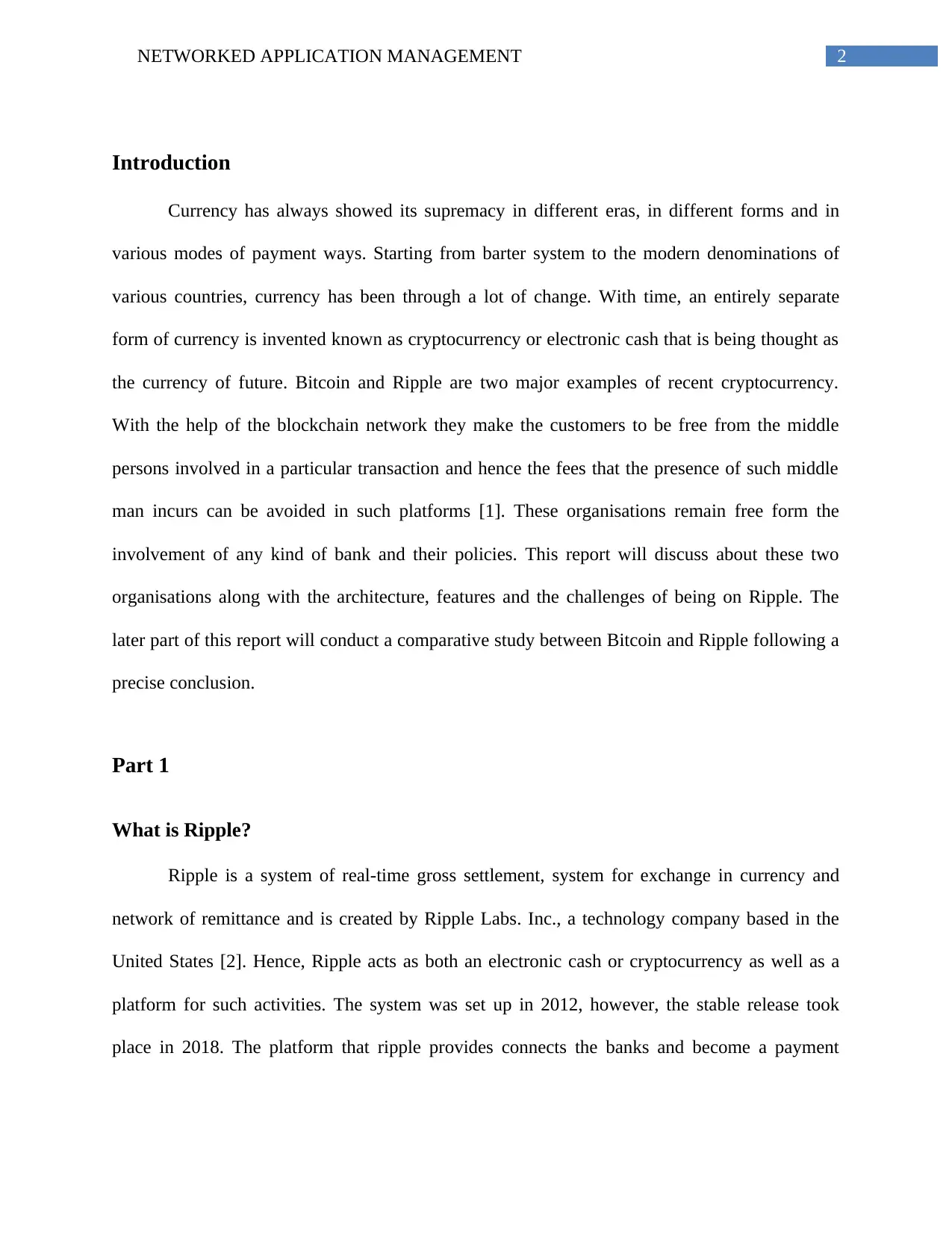
2NETWORKED APPLICATION MANAGEMENT
Introduction
Currency has always showed its supremacy in different eras, in different forms and in
various modes of payment ways. Starting from barter system to the modern denominations of
various countries, currency has been through a lot of change. With time, an entirely separate
form of currency is invented known as cryptocurrency or electronic cash that is being thought as
the currency of future. Bitcoin and Ripple are two major examples of recent cryptocurrency.
With the help of the blockchain network they make the customers to be free from the middle
persons involved in a particular transaction and hence the fees that the presence of such middle
man incurs can be avoided in such platforms [1]. These organisations remain free form the
involvement of any kind of bank and their policies. This report will discuss about these two
organisations along with the architecture, features and the challenges of being on Ripple. The
later part of this report will conduct a comparative study between Bitcoin and Ripple following a
precise conclusion.
Part 1
What is Ripple?
Ripple is a system of real-time gross settlement, system for exchange in currency and
network of remittance and is created by Ripple Labs. Inc., a technology company based in the
United States [2]. Hence, Ripple acts as both an electronic cash or cryptocurrency as well as a
platform for such activities. The system was set up in 2012, however, the stable release took
place in 2018. The platform that ripple provides connects the banks and become a payment
Introduction
Currency has always showed its supremacy in different eras, in different forms and in
various modes of payment ways. Starting from barter system to the modern denominations of
various countries, currency has been through a lot of change. With time, an entirely separate
form of currency is invented known as cryptocurrency or electronic cash that is being thought as
the currency of future. Bitcoin and Ripple are two major examples of recent cryptocurrency.
With the help of the blockchain network they make the customers to be free from the middle
persons involved in a particular transaction and hence the fees that the presence of such middle
man incurs can be avoided in such platforms [1]. These organisations remain free form the
involvement of any kind of bank and their policies. This report will discuss about these two
organisations along with the architecture, features and the challenges of being on Ripple. The
later part of this report will conduct a comparative study between Bitcoin and Ripple following a
precise conclusion.
Part 1
What is Ripple?
Ripple is a system of real-time gross settlement, system for exchange in currency and
network of remittance and is created by Ripple Labs. Inc., a technology company based in the
United States [2]. Hence, Ripple acts as both an electronic cash or cryptocurrency as well as a
platform for such activities. The system was set up in 2012, however, the stable release took
place in 2018. The platform that ripple provides connects the banks and become a payment
⊘ This is a preview!⊘
Do you want full access?
Subscribe today to unlock all pages.

Trusted by 1+ million students worldwide
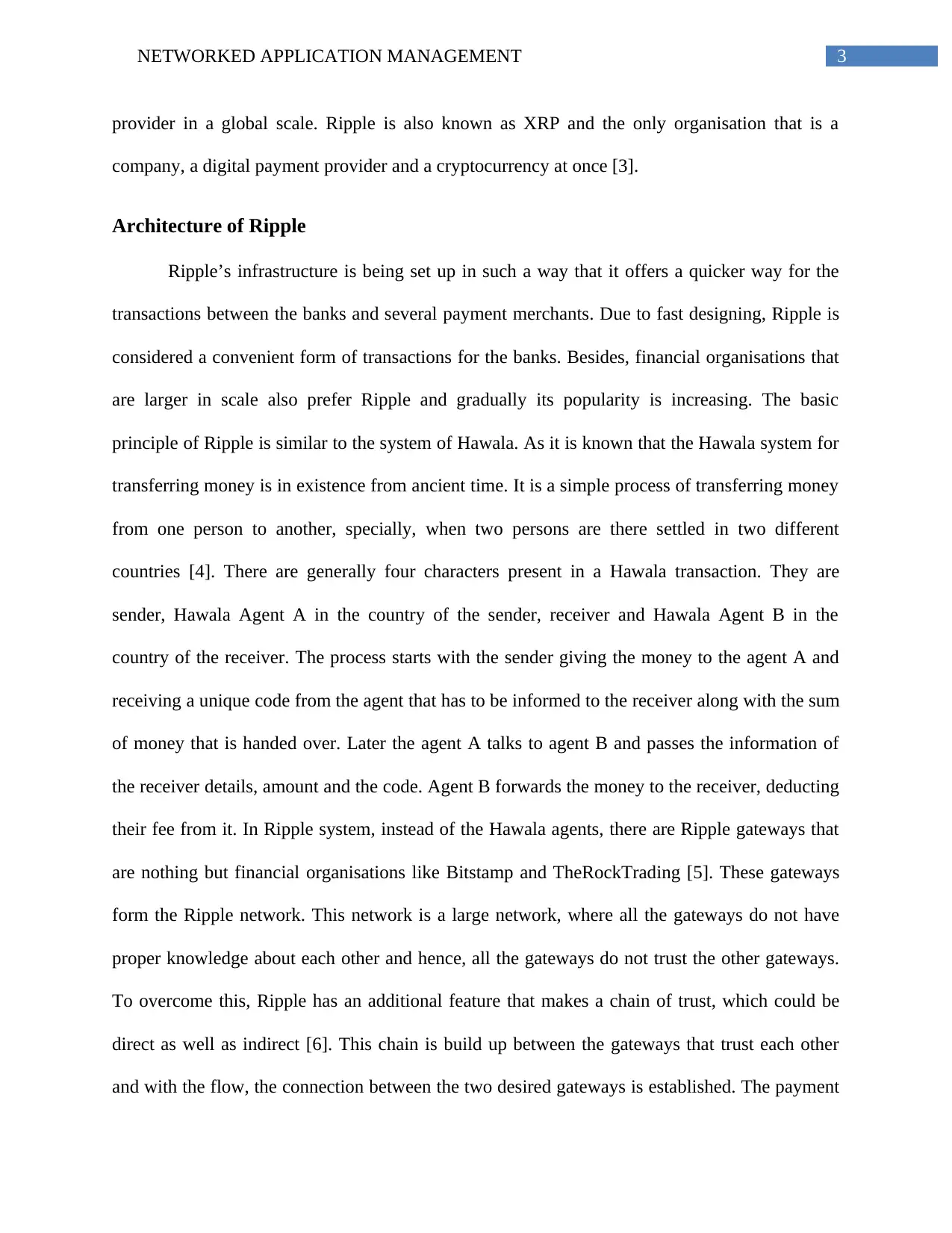
3NETWORKED APPLICATION MANAGEMENT
provider in a global scale. Ripple is also known as XRP and the only organisation that is a
company, a digital payment provider and a cryptocurrency at once [3].
Architecture of Ripple
Ripple’s infrastructure is being set up in such a way that it offers a quicker way for the
transactions between the banks and several payment merchants. Due to fast designing, Ripple is
considered a convenient form of transactions for the banks. Besides, financial organisations that
are larger in scale also prefer Ripple and gradually its popularity is increasing. The basic
principle of Ripple is similar to the system of Hawala. As it is known that the Hawala system for
transferring money is in existence from ancient time. It is a simple process of transferring money
from one person to another, specially, when two persons are there settled in two different
countries [4]. There are generally four characters present in a Hawala transaction. They are
sender, Hawala Agent A in the country of the sender, receiver and Hawala Agent B in the
country of the receiver. The process starts with the sender giving the money to the agent A and
receiving a unique code from the agent that has to be informed to the receiver along with the sum
of money that is handed over. Later the agent A talks to agent B and passes the information of
the receiver details, amount and the code. Agent B forwards the money to the receiver, deducting
their fee from it. In Ripple system, instead of the Hawala agents, there are Ripple gateways that
are nothing but financial organisations like Bitstamp and TheRockTrading [5]. These gateways
form the Ripple network. This network is a large network, where all the gateways do not have
proper knowledge about each other and hence, all the gateways do not trust the other gateways.
To overcome this, Ripple has an additional feature that makes a chain of trust, which could be
direct as well as indirect [6]. This chain is build up between the gateways that trust each other
and with the flow, the connection between the two desired gateways is established. The payment
provider in a global scale. Ripple is also known as XRP and the only organisation that is a
company, a digital payment provider and a cryptocurrency at once [3].
Architecture of Ripple
Ripple’s infrastructure is being set up in such a way that it offers a quicker way for the
transactions between the banks and several payment merchants. Due to fast designing, Ripple is
considered a convenient form of transactions for the banks. Besides, financial organisations that
are larger in scale also prefer Ripple and gradually its popularity is increasing. The basic
principle of Ripple is similar to the system of Hawala. As it is known that the Hawala system for
transferring money is in existence from ancient time. It is a simple process of transferring money
from one person to another, specially, when two persons are there settled in two different
countries [4]. There are generally four characters present in a Hawala transaction. They are
sender, Hawala Agent A in the country of the sender, receiver and Hawala Agent B in the
country of the receiver. The process starts with the sender giving the money to the agent A and
receiving a unique code from the agent that has to be informed to the receiver along with the sum
of money that is handed over. Later the agent A talks to agent B and passes the information of
the receiver details, amount and the code. Agent B forwards the money to the receiver, deducting
their fee from it. In Ripple system, instead of the Hawala agents, there are Ripple gateways that
are nothing but financial organisations like Bitstamp and TheRockTrading [5]. These gateways
form the Ripple network. This network is a large network, where all the gateways do not have
proper knowledge about each other and hence, all the gateways do not trust the other gateways.
To overcome this, Ripple has an additional feature that makes a chain of trust, which could be
direct as well as indirect [6]. This chain is build up between the gateways that trust each other
and with the flow, the connection between the two desired gateways is established. The payment
Paraphrase This Document
Need a fresh take? Get an instant paraphrase of this document with our AI Paraphraser
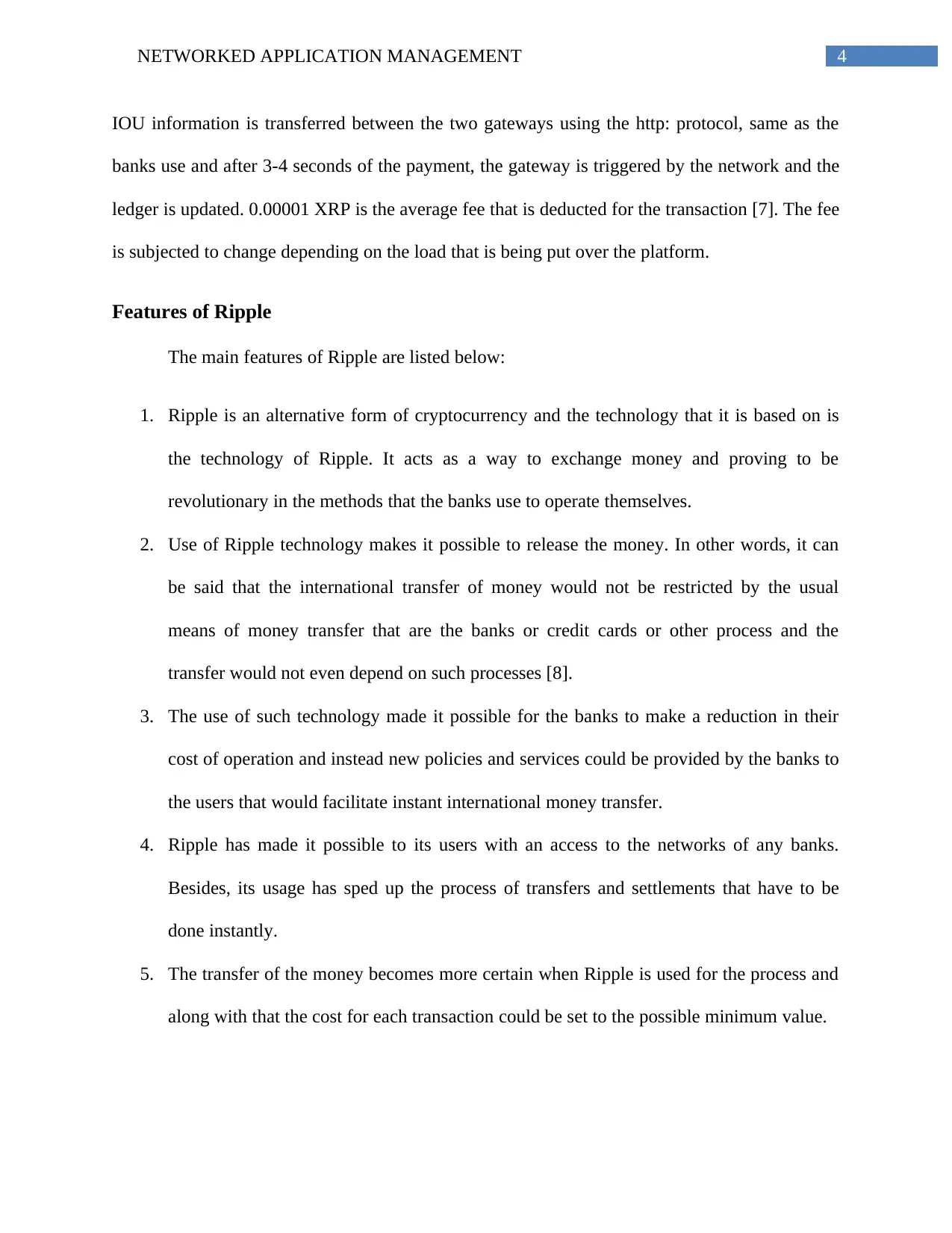
4NETWORKED APPLICATION MANAGEMENT
IOU information is transferred between the two gateways using the http: protocol, same as the
banks use and after 3-4 seconds of the payment, the gateway is triggered by the network and the
ledger is updated. 0.00001 XRP is the average fee that is deducted for the transaction [7]. The fee
is subjected to change depending on the load that is being put over the platform.
Features of Ripple
The main features of Ripple are listed below:
1. Ripple is an alternative form of cryptocurrency and the technology that it is based on is
the technology of Ripple. It acts as a way to exchange money and proving to be
revolutionary in the methods that the banks use to operate themselves.
2. Use of Ripple technology makes it possible to release the money. In other words, it can
be said that the international transfer of money would not be restricted by the usual
means of money transfer that are the banks or credit cards or other process and the
transfer would not even depend on such processes [8].
3. The use of such technology made it possible for the banks to make a reduction in their
cost of operation and instead new policies and services could be provided by the banks to
the users that would facilitate instant international money transfer.
4. Ripple has made it possible to its users with an access to the networks of any banks.
Besides, its usage has sped up the process of transfers and settlements that have to be
done instantly.
5. The transfer of the money becomes more certain when Ripple is used for the process and
along with that the cost for each transaction could be set to the possible minimum value.
IOU information is transferred between the two gateways using the http: protocol, same as the
banks use and after 3-4 seconds of the payment, the gateway is triggered by the network and the
ledger is updated. 0.00001 XRP is the average fee that is deducted for the transaction [7]. The fee
is subjected to change depending on the load that is being put over the platform.
Features of Ripple
The main features of Ripple are listed below:
1. Ripple is an alternative form of cryptocurrency and the technology that it is based on is
the technology of Ripple. It acts as a way to exchange money and proving to be
revolutionary in the methods that the banks use to operate themselves.
2. Use of Ripple technology makes it possible to release the money. In other words, it can
be said that the international transfer of money would not be restricted by the usual
means of money transfer that are the banks or credit cards or other process and the
transfer would not even depend on such processes [8].
3. The use of such technology made it possible for the banks to make a reduction in their
cost of operation and instead new policies and services could be provided by the banks to
the users that would facilitate instant international money transfer.
4. Ripple has made it possible to its users with an access to the networks of any banks.
Besides, its usage has sped up the process of transfers and settlements that have to be
done instantly.
5. The transfer of the money becomes more certain when Ripple is used for the process and
along with that the cost for each transaction could be set to the possible minimum value.
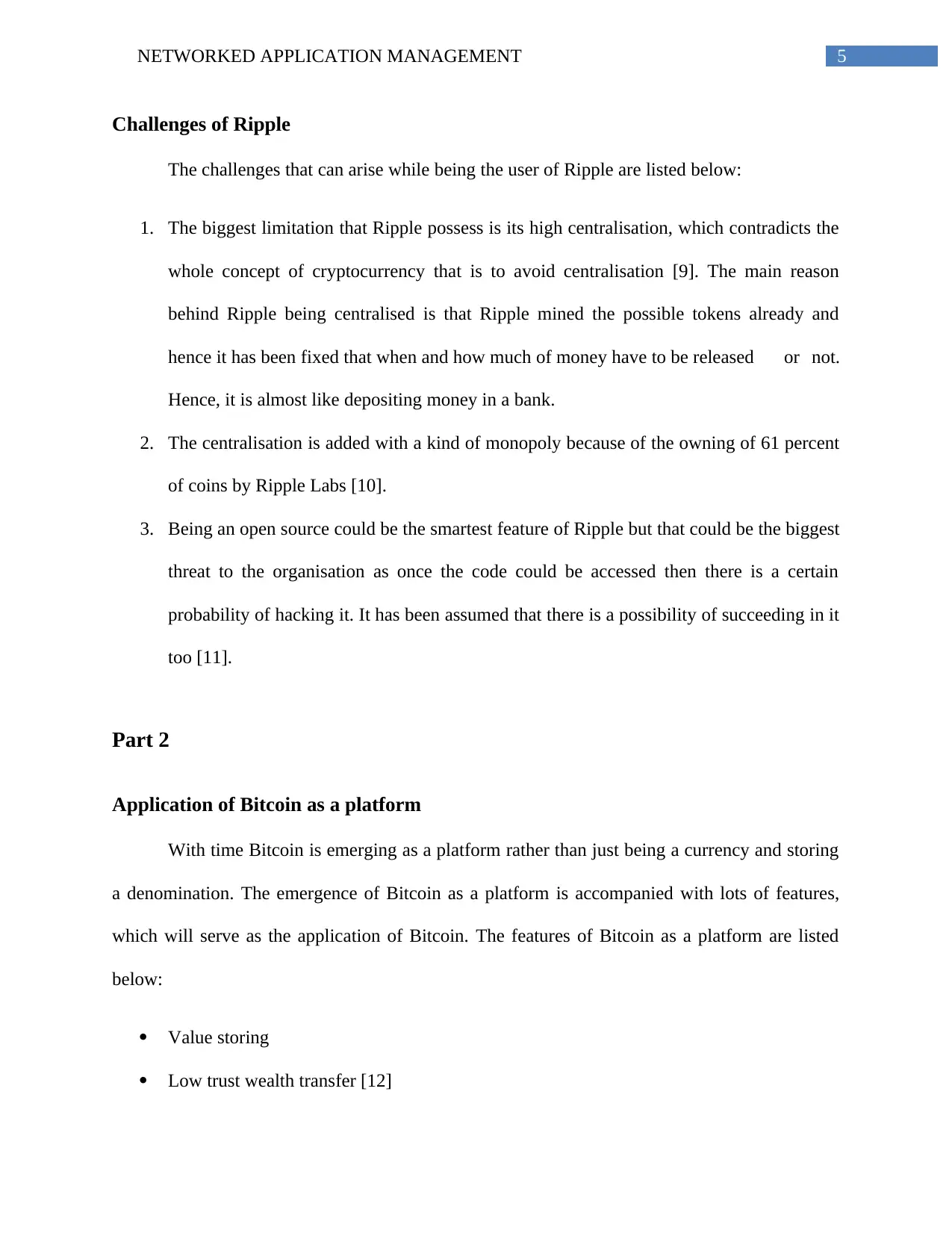
5NETWORKED APPLICATION MANAGEMENT
Challenges of Ripple
The challenges that can arise while being the user of Ripple are listed below:
1. The biggest limitation that Ripple possess is its high centralisation, which contradicts the
whole concept of cryptocurrency that is to avoid centralisation [9]. The main reason
behind Ripple being centralised is that Ripple mined the possible tokens already and
hence it has been fixed that when and how much of money have to be released or not.
Hence, it is almost like depositing money in a bank.
2. The centralisation is added with a kind of monopoly because of the owning of 61 percent
of coins by Ripple Labs [10].
3. Being an open source could be the smartest feature of Ripple but that could be the biggest
threat to the organisation as once the code could be accessed then there is a certain
probability of hacking it. It has been assumed that there is a possibility of succeeding in it
too [11].
Part 2
Application of Bitcoin as a platform
With time Bitcoin is emerging as a platform rather than just being a currency and storing
a denomination. The emergence of Bitcoin as a platform is accompanied with lots of features,
which will serve as the application of Bitcoin. The features of Bitcoin as a platform are listed
below:
Value storing
Low trust wealth transfer [12]
Challenges of Ripple
The challenges that can arise while being the user of Ripple are listed below:
1. The biggest limitation that Ripple possess is its high centralisation, which contradicts the
whole concept of cryptocurrency that is to avoid centralisation [9]. The main reason
behind Ripple being centralised is that Ripple mined the possible tokens already and
hence it has been fixed that when and how much of money have to be released or not.
Hence, it is almost like depositing money in a bank.
2. The centralisation is added with a kind of monopoly because of the owning of 61 percent
of coins by Ripple Labs [10].
3. Being an open source could be the smartest feature of Ripple but that could be the biggest
threat to the organisation as once the code could be accessed then there is a certain
probability of hacking it. It has been assumed that there is a possibility of succeeding in it
too [11].
Part 2
Application of Bitcoin as a platform
With time Bitcoin is emerging as a platform rather than just being a currency and storing
a denomination. The emergence of Bitcoin as a platform is accompanied with lots of features,
which will serve as the application of Bitcoin. The features of Bitcoin as a platform are listed
below:
Value storing
Low trust wealth transfer [12]
⊘ This is a preview!⊘
Do you want full access?
Subscribe today to unlock all pages.

Trusted by 1+ million students worldwide
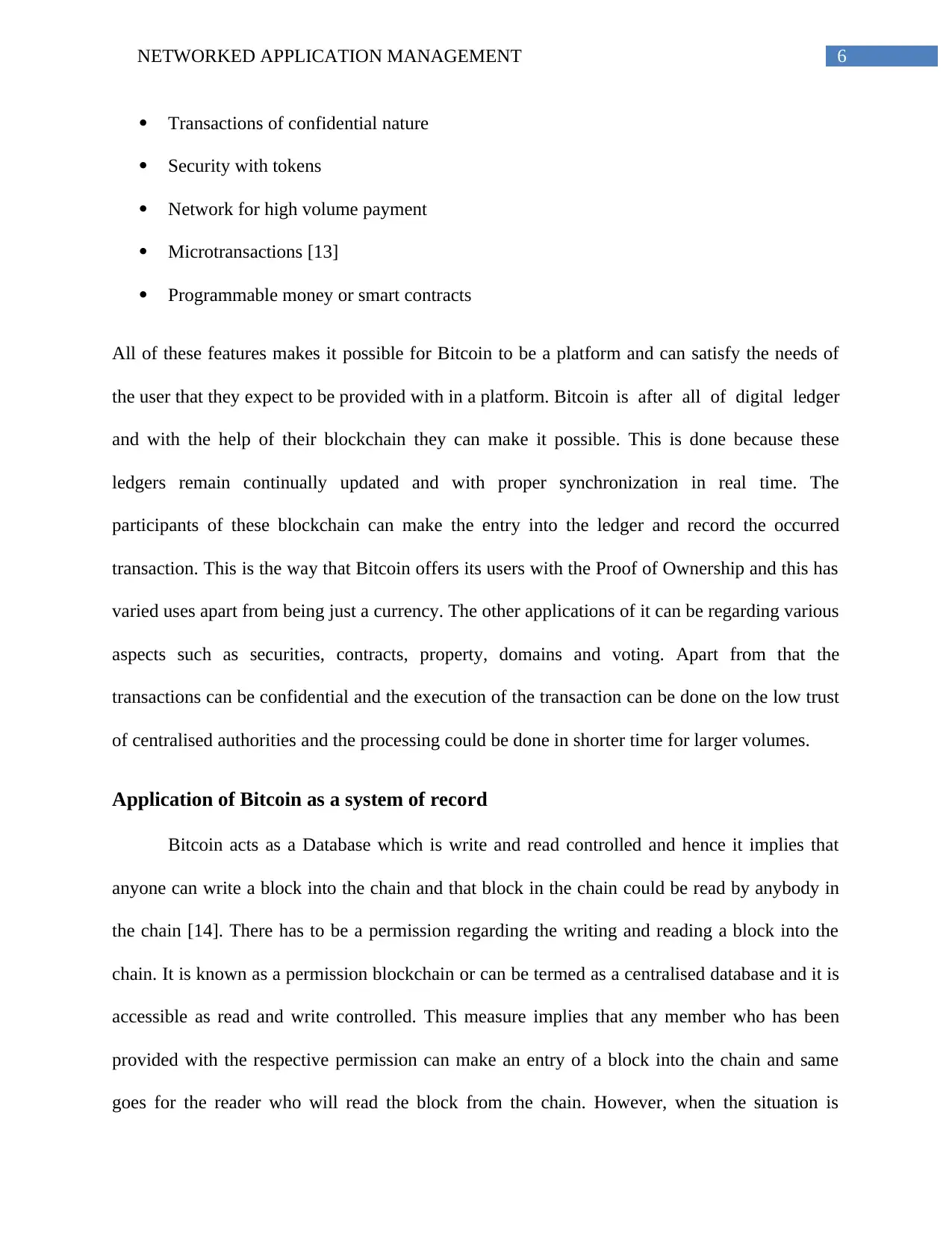
6NETWORKED APPLICATION MANAGEMENT
Transactions of confidential nature
Security with tokens
Network for high volume payment
Microtransactions [13]
Programmable money or smart contracts
All of these features makes it possible for Bitcoin to be a platform and can satisfy the needs of
the user that they expect to be provided with in a platform. Bitcoin is after all of digital ledger
and with the help of their blockchain they can make it possible. This is done because these
ledgers remain continually updated and with proper synchronization in real time. The
participants of these blockchain can make the entry into the ledger and record the occurred
transaction. This is the way that Bitcoin offers its users with the Proof of Ownership and this has
varied uses apart from being just a currency. The other applications of it can be regarding various
aspects such as securities, contracts, property, domains and voting. Apart from that the
transactions can be confidential and the execution of the transaction can be done on the low trust
of centralised authorities and the processing could be done in shorter time for larger volumes.
Application of Bitcoin as a system of record
Bitcoin acts as a Database which is write and read controlled and hence it implies that
anyone can write a block into the chain and that block in the chain could be read by anybody in
the chain [14]. There has to be a permission regarding the writing and reading a block into the
chain. It is known as a permission blockchain or can be termed as a centralised database and it is
accessible as read and write controlled. This measure implies that any member who has been
provided with the respective permission can make an entry of a block into the chain and same
goes for the reader who will read the block from the chain. However, when the situation is
Transactions of confidential nature
Security with tokens
Network for high volume payment
Microtransactions [13]
Programmable money or smart contracts
All of these features makes it possible for Bitcoin to be a platform and can satisfy the needs of
the user that they expect to be provided with in a platform. Bitcoin is after all of digital ledger
and with the help of their blockchain they can make it possible. This is done because these
ledgers remain continually updated and with proper synchronization in real time. The
participants of these blockchain can make the entry into the ledger and record the occurred
transaction. This is the way that Bitcoin offers its users with the Proof of Ownership and this has
varied uses apart from being just a currency. The other applications of it can be regarding various
aspects such as securities, contracts, property, domains and voting. Apart from that the
transactions can be confidential and the execution of the transaction can be done on the low trust
of centralised authorities and the processing could be done in shorter time for larger volumes.
Application of Bitcoin as a system of record
Bitcoin acts as a Database which is write and read controlled and hence it implies that
anyone can write a block into the chain and that block in the chain could be read by anybody in
the chain [14]. There has to be a permission regarding the writing and reading a block into the
chain. It is known as a permission blockchain or can be termed as a centralised database and it is
accessible as read and write controlled. This measure implies that any member who has been
provided with the respective permission can make an entry of a block into the chain and same
goes for the reader who will read the block from the chain. However, when the situation is
Paraphrase This Document
Need a fresh take? Get an instant paraphrase of this document with our AI Paraphraser
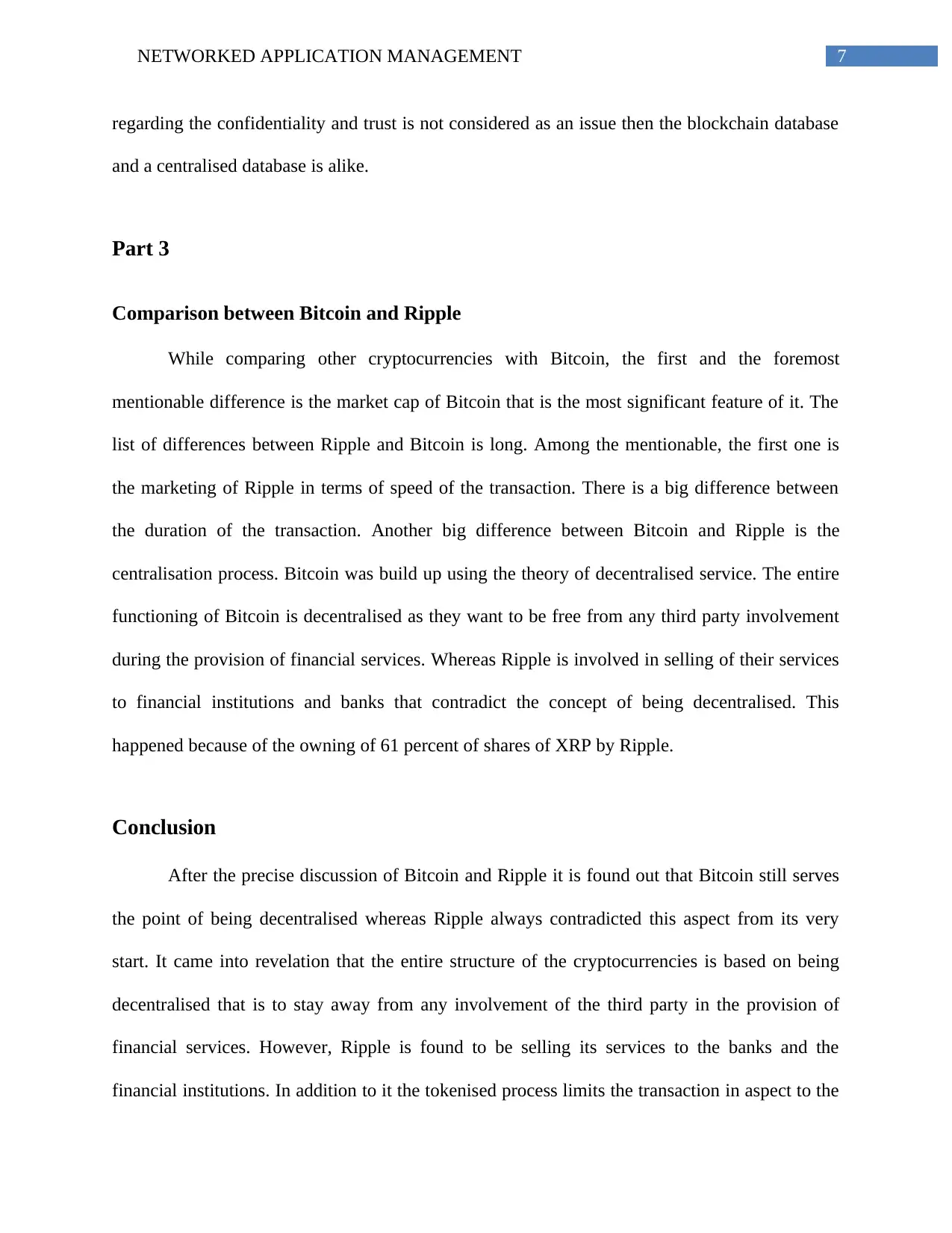
7NETWORKED APPLICATION MANAGEMENT
regarding the confidentiality and trust is not considered as an issue then the blockchain database
and a centralised database is alike.
Part 3
Comparison between Bitcoin and Ripple
While comparing other cryptocurrencies with Bitcoin, the first and the foremost
mentionable difference is the market cap of Bitcoin that is the most significant feature of it. The
list of differences between Ripple and Bitcoin is long. Among the mentionable, the first one is
the marketing of Ripple in terms of speed of the transaction. There is a big difference between
the duration of the transaction. Another big difference between Bitcoin and Ripple is the
centralisation process. Bitcoin was build up using the theory of decentralised service. The entire
functioning of Bitcoin is decentralised as they want to be free from any third party involvement
during the provision of financial services. Whereas Ripple is involved in selling of their services
to financial institutions and banks that contradict the concept of being decentralised. This
happened because of the owning of 61 percent of shares of XRP by Ripple.
Conclusion
After the precise discussion of Bitcoin and Ripple it is found out that Bitcoin still serves
the point of being decentralised whereas Ripple always contradicted this aspect from its very
start. It came into revelation that the entire structure of the cryptocurrencies is based on being
decentralised that is to stay away from any involvement of the third party in the provision of
financial services. However, Ripple is found to be selling its services to the banks and the
financial institutions. In addition to it the tokenised process limits the transaction in aspect to the
regarding the confidentiality and trust is not considered as an issue then the blockchain database
and a centralised database is alike.
Part 3
Comparison between Bitcoin and Ripple
While comparing other cryptocurrencies with Bitcoin, the first and the foremost
mentionable difference is the market cap of Bitcoin that is the most significant feature of it. The
list of differences between Ripple and Bitcoin is long. Among the mentionable, the first one is
the marketing of Ripple in terms of speed of the transaction. There is a big difference between
the duration of the transaction. Another big difference between Bitcoin and Ripple is the
centralisation process. Bitcoin was build up using the theory of decentralised service. The entire
functioning of Bitcoin is decentralised as they want to be free from any third party involvement
during the provision of financial services. Whereas Ripple is involved in selling of their services
to financial institutions and banks that contradict the concept of being decentralised. This
happened because of the owning of 61 percent of shares of XRP by Ripple.
Conclusion
After the precise discussion of Bitcoin and Ripple it is found out that Bitcoin still serves
the point of being decentralised whereas Ripple always contradicted this aspect from its very
start. It came into revelation that the entire structure of the cryptocurrencies is based on being
decentralised that is to stay away from any involvement of the third party in the provision of
financial services. However, Ripple is found to be selling its services to the banks and the
financial institutions. In addition to it the tokenised process limits the transaction in aspect to the
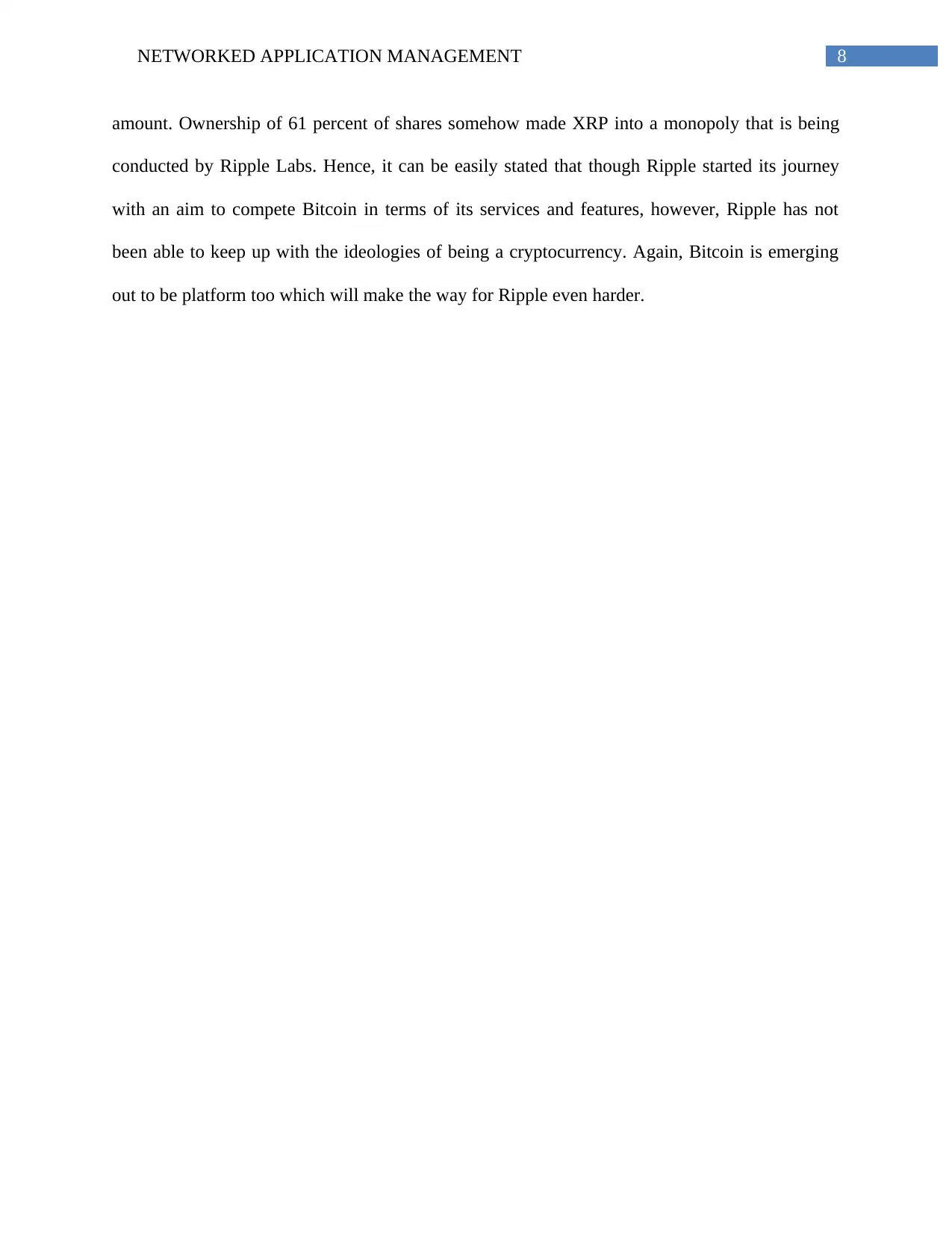
8NETWORKED APPLICATION MANAGEMENT
amount. Ownership of 61 percent of shares somehow made XRP into a monopoly that is being
conducted by Ripple Labs. Hence, it can be easily stated that though Ripple started its journey
with an aim to compete Bitcoin in terms of its services and features, however, Ripple has not
been able to keep up with the ideologies of being a cryptocurrency. Again, Bitcoin is emerging
out to be platform too which will make the way for Ripple even harder.
amount. Ownership of 61 percent of shares somehow made XRP into a monopoly that is being
conducted by Ripple Labs. Hence, it can be easily stated that though Ripple started its journey
with an aim to compete Bitcoin in terms of its services and features, however, Ripple has not
been able to keep up with the ideologies of being a cryptocurrency. Again, Bitcoin is emerging
out to be platform too which will make the way for Ripple even harder.
⊘ This is a preview!⊘
Do you want full access?
Subscribe today to unlock all pages.

Trusted by 1+ million students worldwide

9NETWORKED APPLICATION MANAGEMENT
References
[1] Narayanan, A., Bonneau, J., Felten, E., Miller, A. and Goldfeder, S., 2016. Bitcoin and
cryptocurrency technologies: a comprehensive introduction. Princeton University Press.
[2] Armknecht, F., Karame, G.O., Mandal, A., Youssef, F. and Zenner, E., 2015, August.
Ripple: Overview and outlook. In International Conference on Trust and Trustworthy
Computing (pp. 163-180). Springer, Cham.
[3] Rosner, M.T. and Kang, A., 2015. Understanding and regulating twenty-first century
payment systems: The ripple case study. Mich. L. Rev., 114, p.649.
[4] Sharif, K., Mahama, H. and Farooqi, N., 2016. MANAGEMENT, CONTROL AND
GOVERNANCE OF HAWALA NETWORKS IN THE GULF COOPERATION
COUNCIL REGION. Asian Academy of Management Journal of Accounting & Finance,
12(2).
[5] Pieters, G. and Vivanco, S., 2017. Financial regulations and price inconsistencies across
Bitcoin markets. Information Economics and Policy, 39, pp.1-14.
[6] Takashima, I., 2018. Ripple: The Ultimate Guide to the World of Ripple XRP, Ripple
Investing, Ripple Coin, Ripple Cryptocurrency, Cryptocurrency.
[7] Domingues, C., 2018. Allvor: cryptocurrency for e-commerce powered by the XRP
Ledger.
[8] Noroozi, A., Jafari Samimi, A. and Gilak Hakim Abadi, M.T., 2019. An Analysis of
Circulation of Decentralized Digital Money in Quantum Electrodynamics Space: the
References
[1] Narayanan, A., Bonneau, J., Felten, E., Miller, A. and Goldfeder, S., 2016. Bitcoin and
cryptocurrency technologies: a comprehensive introduction. Princeton University Press.
[2] Armknecht, F., Karame, G.O., Mandal, A., Youssef, F. and Zenner, E., 2015, August.
Ripple: Overview and outlook. In International Conference on Trust and Trustworthy
Computing (pp. 163-180). Springer, Cham.
[3] Rosner, M.T. and Kang, A., 2015. Understanding and regulating twenty-first century
payment systems: The ripple case study. Mich. L. Rev., 114, p.649.
[4] Sharif, K., Mahama, H. and Farooqi, N., 2016. MANAGEMENT, CONTROL AND
GOVERNANCE OF HAWALA NETWORKS IN THE GULF COOPERATION
COUNCIL REGION. Asian Academy of Management Journal of Accounting & Finance,
12(2).
[5] Pieters, G. and Vivanco, S., 2017. Financial regulations and price inconsistencies across
Bitcoin markets. Information Economics and Policy, 39, pp.1-14.
[6] Takashima, I., 2018. Ripple: The Ultimate Guide to the World of Ripple XRP, Ripple
Investing, Ripple Coin, Ripple Cryptocurrency, Cryptocurrency.
[7] Domingues, C., 2018. Allvor: cryptocurrency for e-commerce powered by the XRP
Ledger.
[8] Noroozi, A., Jafari Samimi, A. and Gilak Hakim Abadi, M.T., 2019. An Analysis of
Circulation of Decentralized Digital Money in Quantum Electrodynamics Space: the
Paraphrase This Document
Need a fresh take? Get an instant paraphrase of this document with our AI Paraphraser
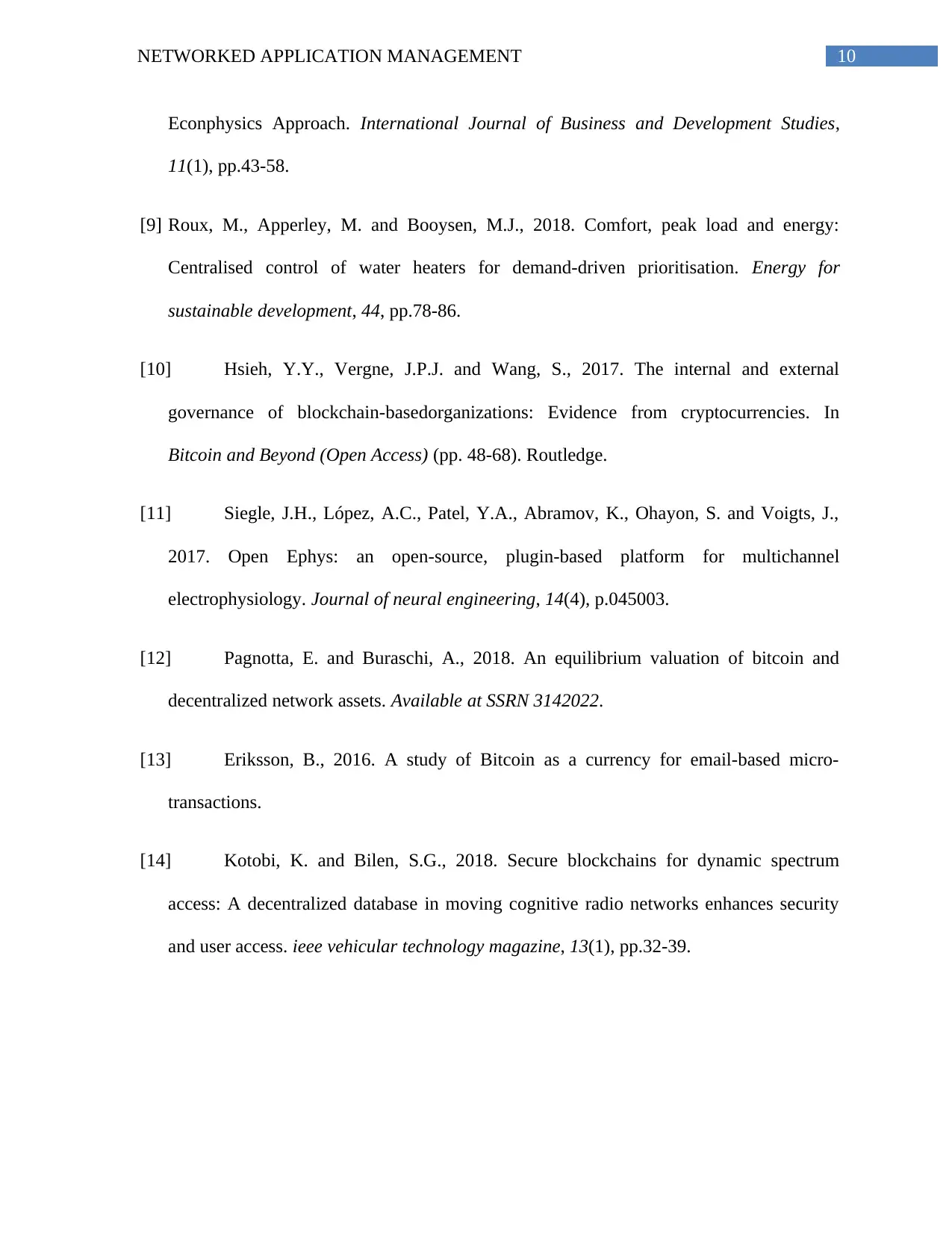
10NETWORKED APPLICATION MANAGEMENT
Econphysics Approach. International Journal of Business and Development Studies,
11(1), pp.43-58.
[9] Roux, M., Apperley, M. and Booysen, M.J., 2018. Comfort, peak load and energy:
Centralised control of water heaters for demand-driven prioritisation. Energy for
sustainable development, 44, pp.78-86.
[10] Hsieh, Y.Y., Vergne, J.P.J. and Wang, S., 2017. The internal and external
governance of blockchain-basedorganizations: Evidence from cryptocurrencies. In
Bitcoin and Beyond (Open Access) (pp. 48-68). Routledge.
[11] Siegle, J.H., López, A.C., Patel, Y.A., Abramov, K., Ohayon, S. and Voigts, J.,
2017. Open Ephys: an open-source, plugin-based platform for multichannel
electrophysiology. Journal of neural engineering, 14(4), p.045003.
[12] Pagnotta, E. and Buraschi, A., 2018. An equilibrium valuation of bitcoin and
decentralized network assets. Available at SSRN 3142022.
[13] Eriksson, B., 2016. A study of Bitcoin as a currency for email-based micro-
transactions.
[14] Kotobi, K. and Bilen, S.G., 2018. Secure blockchains for dynamic spectrum
access: A decentralized database in moving cognitive radio networks enhances security
and user access. ieee vehicular technology magazine, 13(1), pp.32-39.
Econphysics Approach. International Journal of Business and Development Studies,
11(1), pp.43-58.
[9] Roux, M., Apperley, M. and Booysen, M.J., 2018. Comfort, peak load and energy:
Centralised control of water heaters for demand-driven prioritisation. Energy for
sustainable development, 44, pp.78-86.
[10] Hsieh, Y.Y., Vergne, J.P.J. and Wang, S., 2017. The internal and external
governance of blockchain-basedorganizations: Evidence from cryptocurrencies. In
Bitcoin and Beyond (Open Access) (pp. 48-68). Routledge.
[11] Siegle, J.H., López, A.C., Patel, Y.A., Abramov, K., Ohayon, S. and Voigts, J.,
2017. Open Ephys: an open-source, plugin-based platform for multichannel
electrophysiology. Journal of neural engineering, 14(4), p.045003.
[12] Pagnotta, E. and Buraschi, A., 2018. An equilibrium valuation of bitcoin and
decentralized network assets. Available at SSRN 3142022.
[13] Eriksson, B., 2016. A study of Bitcoin as a currency for email-based micro-
transactions.
[14] Kotobi, K. and Bilen, S.G., 2018. Secure blockchains for dynamic spectrum
access: A decentralized database in moving cognitive radio networks enhances security
and user access. ieee vehicular technology magazine, 13(1), pp.32-39.
1 out of 11
Related Documents
Your All-in-One AI-Powered Toolkit for Academic Success.
+13062052269
info@desklib.com
Available 24*7 on WhatsApp / Email
![[object Object]](/_next/static/media/star-bottom.7253800d.svg)
Unlock your academic potential
Copyright © 2020–2025 A2Z Services. All Rights Reserved. Developed and managed by ZUCOL.



